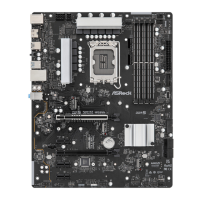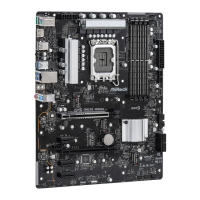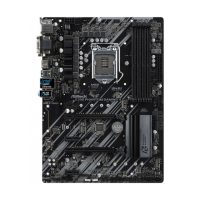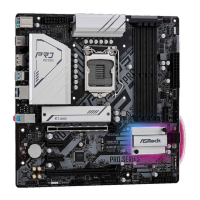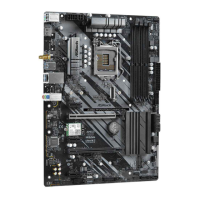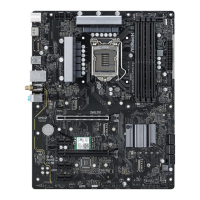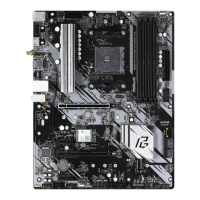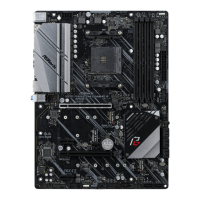Do you have a question about the ASROCK Z690M Phantom Gaming 4 and is the answer not in the manual?
Lists all items included in the motherboard package.
Details the technical specifications of the motherboard hardware.
Illustrates the physical layout and component placement on the motherboard.
Describes the rear panel connectors and their functions.
Important safety and handling guidelines before installing components.
Step-by-step guide for correctly installing the CPU into the socket.
Instructions for mounting the CPU cooler and fan assembly.
Guide on how to properly install RAM modules into the motherboard slots.
Information on using PCIe slots for graphics cards and other expansion devices.
Details on configuring motherboard jumpers, such as the Clear CMOS jumper.
Identifies and explains the function of various internal headers and connectors.
Explains the function of the Post Status Checker for diagnosing boot issues.
Specific steps for installing dual graphics cards for CrossFireX.
Instructions for installing drivers and enabling CrossFireX functionality.
Steps for installing a wireless module into the M.2 slot.
Guide for installing an M.2 NVMe SSD in the M2_1 slot.
Guide for installing an M.2 NVMe SSD in the M2_2 slot.
Instructions for installing essential drivers from the support CD.
Guide to using the ASRock utility for system tuning and monitoring.
Information on using the ASRock store for software and updates.
Overview of the Nahimic audio enhancement software features.
Guide for customizing RGB lighting effects using ASRock software.
Explains the purpose and navigation of the UEFI Setup Utility.
Overview of the simplified BIOS setup interface.
Access to comprehensive BIOS settings and configurations.
Description of the main navigation menus within the UEFI utility.
Explains keyboard shortcuts for navigating the UEFI interface.
Displays system overview and basic information upon entering UEFI.
Settings for overclocking the CPU, memory, and other system components.
Detailed system configuration options beyond basic settings.
Settings related to CPU features, power states, and performance.
Configuration options for the motherboard chipset and integrated peripherals.
Settings for managing SATA and M.2 storage devices.
Configuration options for Thunderbolt connectivity and features.
Settings for power management and system sleep states.
Options for configuring USB controller behavior.
Settings for security features related to TPM modules.
Access to utility tools like BIOS flashing and RAID setup.
Displays system temperatures, fan speeds, and voltages.
Options for setting system passwords and secure boot.
Settings for configuring boot order and boot behavior.
Options for saving or discarding UEFI settings and exiting the utility.
| Audio chip | Realtek ALC897 |
|---|---|
| Certification | FCC, CE, ErP/EuP |
| Component for | PC |
| Motherboard chipset | Intel Z690 |
| PC health monitoring | FAN, Temperature, Voltage |
| Audio output channels | 7.1 channels |
| Motherboard form factor | micro ATX |
| Motherboard chipset family | Intel |
| Windows operating systems supported | Windows 10 x64, Windows 11 x64 |
| Cables included | SATA |
| Drivers included | Yes |
| USB 2.0 ports quantity | 0 |
| USB 3.2 Gen 1 (3.1 Gen 1) Type-A ports quantity | 4 |
| USB 3.2 Gen 2 (3.1 Gen 2) Type-A ports quantity | 2 |
| RAID levels | 0, 1, 5, 10 |
| Supported storage drive types | HDD & SSD |
| Supported storage drive interfaces | M.2, SATA III |
| Wi-Fi | No |
| LAN controller | Intel® I219-V |
| Ethernet interface type | Gigabit Ethernet |
| Maximum resolution | 4096 x 2160 pixels |
| Parallel processing technology support | - |
| BIOS type | UEFI AMI |
| ACPI version | 6.0 |
| BIOS memory size | 128 Mbit |
| System Management BIOS (SMBIOS) version | 2.7 |
| Memory channels | Dual-channel |
| Memory slots type | DIMM |
| Supported memory types | DDR4-SDRAM |
| Maximum internal memory | 128 GB |
| Supported memory clock speeds | 4800 MHz |
| Processor socket | LGA 1700 |
| Compatible processor series | Intel Celeron, Intel Core i3, Intel Core i5, Intel Core i7, Intel Core i9, Intel Pentium |
| Harmonized System (HS) code | 84733020 |
| Weight | 1000 g |
| Width | 244 mm |
|---|---|
| Height | 65 mm |

